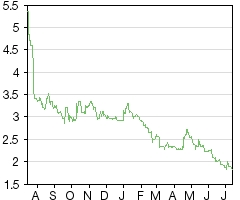Firibastat in hypertension
In June 2017, Quantum Genomics reported the results from the Phase IIa pilot study of firibastat for the treatment of patients with mild to moderate essential hypertension. The trial was a randomised, double-blind, crossover study that measured the change in SBP in 34 patients over four weeks. Patients were dosed with 250mg of firibastat twice a day for a one-week lead-in period, followed by 500mg per day. The primary outcome of the study was the reduction in ambulatory SBP measured over daytime hours using a blood pressure monitor. Patients showed a 2.7mmHg improvement in this measure when compared to placebo, although the difference fell short of statistical significance (p=0.16). The patient’s supine in-office blood pressure, measured by a clinician, improved more compared to placebo at 4.7mmHg, although this measure also failed to reach significance (p=0.15). Other blood pressure measurements, including diastolic blood pressure (DBP) were generally insignificant (Exhibit 4).
Exhibit 4: Effect of firibastat on different blood pressure measurements.
Measurement |
Period |
Placebo adjusted change (mmHg) |
SBP |
p |
DBP |
p |
Ambulatory |
Daytime |
-2.70 |
0.16 |
-1.80 |
0.24 |
|
Night-time |
-0.51 |
0.85 |
0.64 |
0.67 |
|
24h |
-2.00 |
0.31 |
-1.04 |
0.48 |
Office |
|
-4.65 |
0.15 |
-0.71 |
0.75 |
This was small for a blood pressure study at only 34 patients (which can often reach into the thousands). It is therefore unfortunate, but not necessarily surprising, that statistical significance was missed. Also, approved blood pressure medications typically show an improvement in SBP (after placebo adjustment) from 9-14mmHg. This effect size is seen across a range of classes treating patients with similar baseline SBP (Exhibit 5). We should note that there is potential for the treatment effect to increase with increased treatment duration and this effect has been shown for instance with Diovan (valsartan).
Exhibit 5: Improvement in SBP from a selection of drugs*
Drug |
Class |
Measurement |
Duration |
Baseline SBP (mmHg) |
Reduction in SBP, placebo adjusted** (mmHg) |
firibastat (QGC001) |
BAPAI |
Daytime ambulatory |
4 weeks |
150 |
2.7 |
firibastat (QGC001) |
BAPAI |
Supine |
4 weeks |
148 |
4.7 |
Vasotec (enalapril) |
ACE inhibitor |
Seated |
4 weeks |
147 |
14 |
Norvasc (amlodipine) |
Calcium channel blocker |
Standing |
24 hours |
N/R |
12 |
Diovan (valsartan) |
ARB |
Supine or Seated |
8 weeks |
151 |
9 |
Tekturna (aliskiren) |
Renin inhibitor |
Seated |
8 weeks |
151 |
12 |
Source: Quantum Genomics, FDA labels, FDA review documents. Note: *For illustrative purposes using historical data and not head-to-head comparisons. **Maximum effective dose reported. BAPAI = brain aminopeptidase A inhibitor. ARB = angiotensin receptor blocker. ACE = angiotensin converting enzyme. N/R = not reported in available documents.
Quantum Genomics carried out a multi-variate analysis that gives some insight into the variables contributing to drug response. The variable with the highest significance was the patient’s baseline daytime SBP prior to entering treatment (p=0.01), because patients with the highest blood pressure when entering the study had the highest response. This is consistent with previous data in rats and humans that suggest the response correlates with disease severity. In previous studies, the drug had no effect on subjects with normal blood pressure.
The second most significant variable was the difference between patients during treatment and while on placebo at p=0.06, which is much better than in the more naive primary analysis. This suggests other confounding imbalances between patients worsened the significance of the primary outcome. These issues can at least in part be addressed through future trial design, in particular a larger patient sample size enabling better randomisation.
The adverse event profile was similar between firibastat and placebo and largely benign (Exhibit 6). Two patients discontinued from the trial due to adverse events, and one withdrew (during the placebo portion) due to severe hypertension. Importantly, the company also did bloodwork on participants and demonstrated that the treatment did not affect any hormones implicated in hypertension (such as renin or aldosterone, among others), suggesting the drug’s effect is the on-target action on BAPA.
Exhibit 6: Firibastat (QGC001) adverse events
|

|
|
|
The company has initiated the NEW-HOPE trial in 250 hypertensive overweight (BMI 25-45kg/m2) patients, with a primary endpoint of change from baseline in office SBP at week eight. SBP at screening will have to be 145-170mmHg if previously untreated, or 130-150mmHg if treated. Following a two-week, run-in period in which there would be no treatment, SBP would need to be 145-170mmHg. Patients will start off on 250mg twice a day (BID) for two weeks and then either continue at that dose or increase to 500mg BID for another two weeks. Following that, patients would either be on 250mg BID, 500mg BID or 500mg BID with 25mg of hydrochlorothiazide, an often-used diuretic, added in.
Exhibit 7: NEW-HOPE study design
|

|
|
|
The company expects that at least 50% of patients will be self-identified as African American or Hispanic. African Americans have a higher prevalence of hypertension compared to other groups, but also, along with Hispanics, are less likely to have their hypertension under control compared to their white counterparts.
Exhibit 8: Percentage of adults with hypertension who have it controlled, by race and sex
|

|
Source: Yoon S et al., NCHS Data Brief. 2015 Nov;(220):1-8
|

















